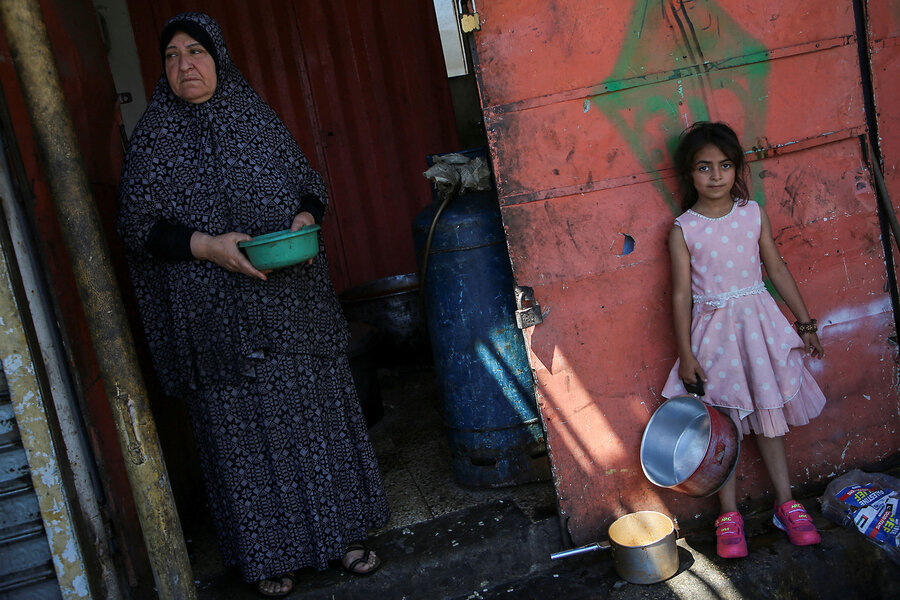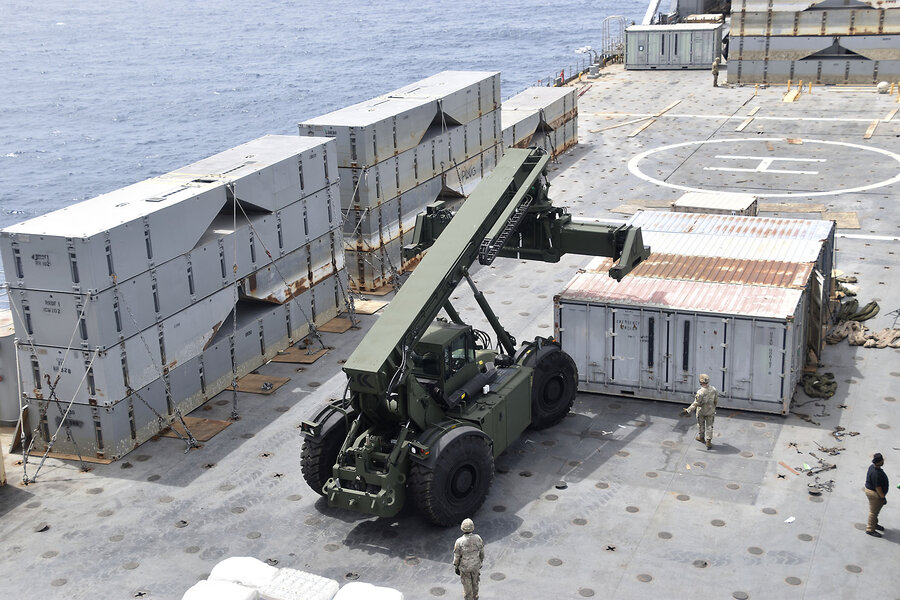How the US floating pier in Gaza will make a difference in the growing hunger crisis
Loading...
The U.S. military says it has finished installing a temporary floating pier off the coast of Israel, a vital step toward delivering desperately needed food to Gaza.
The pier will be used as a route into the 25-mile-long Gaza Strip, which doesn’t having a working port of its own and has seen land routes blocked by war.
Why We Wrote This
The United States recently completed a floating pier to deliver crucial humanitarian aid to Gaza. The effort also brings logistical and security challenges for U.S. forces.
The primary staging ground for this delivery of humanitarian aid via sea will be a floating road-and-dock system. Civilian contractors who are not American citizens will be driving the trucks along a causeway and onto the beach.
Initially, the pier will bring an estimated 90 truckloads of humanitarian aid into Gaza each day. Once it’s fully operational, that number “should jump to about 150 truckloads,” according to the U.S. Department of Defense, or enough food for roughly 2 million meals per day.
The Pentagon has repeatedly emphasized that there will be no U.S. boots on the ground as part of the Gaza pier operation, which involves some 1,000 American service members.
The U.S. military says it has finished installing a temporary floating pier off the coast of Israel, a vital step toward delivering desperately needed food into Gaza.
The pier will be used as a route into the 25-mile-long Gaza Strip, which doesn’t having a working port of its own and has seen land routes blocked by war.
Strong winds and high sea swells initially prevented the U.S. military from emplacing the pier. It was anchored to a beach in Gaza at about 7:40 a.m. Gaza time on Thursday, according to U.S. Central Command.
Why We Wrote This
The United States recently completed a floating pier to deliver crucial humanitarian aid to Gaza. The effort also brings logistical and security challenges for U.S. forces.
How will the pier work?
The primary staging ground for this delivery of humanitarian aid via sea will be a floating road-and-dock system that the U.S. Defense Department, in its affinity for acronyms, has dubbed Joint Logistics Over-the-Shore, or JLOTS.
The first key component of the structure is a floating platform 72 feet wide and 270 feet long that’s located roughly 3 miles off the coast of Gaza.
This is where ships leaving Cyprus loaded with humanitarian aid collected by the U.S. Agency for International Development and other international partners will dock. Next, cargo will be deposited onto trucks parked aboard U.S. Army watercraft waiting at the floating platform.
Because the water near the shore is too shallow for big vessels, these smaller U.S. Army transport boats will then ferry the trucks filled with humanitarian aid to the system’s second key component: an 1,800-foot-long, two-lane floating causeway.
Civilian contractors who are not American citizens will be driving the trucks along the causeway and onto the beach, and the United Nations will oversee aid distribution.
To what extent will the pier help alleviate hunger in Gaza?
Initially, the pier will bring an estimated 90 truckloads of humanitarian aid into Gaza each day.
Once it’s fully operational, that number “should jump to about 150 truckloads,” or enough food for roughly 2 million meals per day, according to Deputy Defense Department Press Secretary Sabrina Singh.
“We’re going to start with an initial small amount of aid trucks to flow in to make sure that the system works, that the distribution works, and then you’ll see that increase” before reaching full operational capacity, she said.
Still, Pentagon officials say that using the pier to deliver aid is not ideal, and that land routes would be better.
“We do want to see those [land crossings] opened up,” Ms. Singh said last week. “It’s meant to help augment, to help complement, other ways that aid can get in.”
Does the pier put U.S. forces at risk?
The Pentagon has repeatedly emphasized that there will be no U.S. boots on the ground as part of the Gaza pier operation, which involves some 1,000 American service members.
Still, the question of safety to U.S. forces is one that Mark Milley, former chairman of the Joint Chiefs of Staff, was asked to address in April congressional testimony.
He acknowledged that it’s possible that U.S. troops could come under fire.
Because U.S. troops will not step foot on land, however, and because Hamas has “limited and inaccurate fires available from rockets and mortars,” the risk to U.S. troops is small, says retired Col. Mark Cancian, senior adviser to the International Security Program at the Center for Strategic and International Studies.
Yet though these fires are inaccurate, Hamas “might eventually get a hit,” he adds.
“This is a combat zone,” Maj. Gen. Pat Ryder, the Pentagon press secretary, said last Thursday. “It’s a dangerous area.”
When asked whether the United States was in communication with Hamas leaders “to make sure that they’re not going to try to scuttle this” pier operation, he said there are “no conversations between DOD and Hamas.”
That said, Major General Ryder added, there’s “no intelligence at this point in time to indicate that Hamas is actively targeting JLOTS or the humanitarian assistance.”
How is the Pentagon planning to protect U.S. forces?
The “significant force protection” security around the pier operations is a “prudent measure” and “sufficient to support execution of the mission,” a senior U.S. defense official said in a background briefing last month.
“But importantly, we reassess security every single day,” the official added.
To help mitigate risk of “friendly fire” attacks, the Pentagon and the Israel Defense Forces have established a deconfliction process to coordinate the humanitarian operations on the pier.
This is also meant to avert the sort of tragedy that occurred with the World Central Kitchen in April, when Israel launched an airstrike on the organization’s clearly marked vehicles, accidentally killing seven aid workers. This occurred even though the charity had cleared its movements with the IDF, which had reportedly approved the delivery.
As for the coordination between the IDF and the U.S. military, Ms. Singh said, “We are confident that we are in a good place.”










